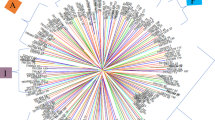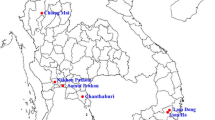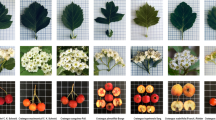Abstract
The objective of this work was to evaluate the genetic variability of Cenchrus ciliaris accessions using morpho-agronomic descriptors for the identification of germplasm with phenotypic divergence that can be used as male parents in breeding programmes for the species. Thirty-eight accessions were characterised using six quantitative and 12 qualitative descriptors. The descriptors that most contributed to the divergence were inflorescence length (22.48%), leaf blade width (19.52%) and leaf blade length (18.35%). Based on the mean grouping test, for the character basal tillering intensity, the accessions were distributed into three groups, of which accessions CPATSA79125 and CPATSA79150 had the most tillers. Thus, there was genetic diversity among the evaluated accessions, with an emphasis on the CPATSA79123 and CPATSA90611 genotypes, as they were the most divergent accessions and thus can be used in clonal selections and in the prospection of genes of agronomic interest. The different accessions can be selected for the most varied objectives of the improvement programmes for the species.

Similar content being viewed by others
References
Antonio RP (2015) Espécies forrageiras: principais contribuições, estado atual e perspectivas para a pesquisa na Embrapa Semi árido. Documentos, 269 - Embrapa Semi-árido AOAC (2002) Métodos oficiais de análise, 17 edition
Appezzato da Glória B (2003) Morfologia de sistemas subterrâneos. In: Pinto AS (ed). Ribeirão Preto, Brazil
Arshad M, Ashraf M, Ahamad M, Zaman F (2007) Morphogenetic variability potential of Cenchrus ciliaris L., from Cholistan desert, Pakistan. Pak J Bot 39(5):1481–1488
Bonato ALV, Calvo ES, Geraldi IO, Arias CAA (2006) Genetic similarity among soybean (Glycine max (L) Merrill) cultivars released in Brazil using AFLP markers. Genet Mol Biol 29(4):692–704
Bruno LRGP, Antonio RP, Assis JGA, Moreira JN, Lira ICSA (2017) Buffel grass morphoagronomic characterization from Cenchrus germplasm active bank. Rev Caatinga 30(2):487–495
Costa NL, Magalhães JA, Townsend CR, Paulino VT (2004) Fisiologia e manejo de plantas forrageiras. Rondônia, Documentos 85, Embrapa Rondônia https://www.infoteca.cnptia.embrapa.br/bitstream/doc/916005/1/doc85plantasforrageiras.pdf
Cruz CD (2016) Genes software–extended and integrated with the R, Matlab and Selegen. Acta Sci-Agron 38(4):547–552
IBGE Censo agropecuário (2021) resultados preliminares. Rio de Janeiro, 2021. Disponível em: https://www.ibge.gov.br/explica/producao-agropecuaria/. Accessed 12 Sep 2023
Jorge MAB, Wouw MVD, Hanson J, Mohammed J (2008) Characterization of a collection of buffel grass (Cenchrus ciliaris). Trop Grassl 42(1):27–39
Karia CT, Andrade RP, Charchar MJDA, Gomes AC (2002) Caracterização morfológica de acessos do gênero Stylosanthes no banco ativo de germoplasma da Embrapa Cerrados: Coleção 1994/1995. Embrapa Cerrados, Planaltina, DF
Mahalanobis PC (1936) On the generalized distance in statistics. Proc Natl Inst Sci India 2(1):9–55
Mansoor U, Hameed M, Wahid A, Rao AR (2002) Ecotypic variability for drought resistance in Cenchrus ciliaris L. germplasm from Cholistan desert in Pakistan. Int J Agric Biol 4(3):392–397
MAPA Ministério da Agricultura e Pecuária (2019) – Instrução para execução de ensaios de distinguibilidade, homogeneidade e estabilidade de capim buffel (Cenchrus ciliaris; Cenchrus pennisetiformis; Cenchrus setigerus emseus híbridos. Brasília 2019. Disponível em: https://www.gov.br/agricultura/pt-br/assuntos/insumosagropecuarios/insumos-agricolas/protecao-de-cultivar/forrageiras Accessed 29 Sep 2023
Marshall VM, Lewis MM, Ostendorf B (2012) Buffel grass (Cenchrus ciliaris) as an invader and threat to biodiversity in arid environments: a review. J Arid Environ 78:1–12. https://doi.org/10.1016/j.jaridenv.2011.11.005
Mojena R (1977) Hierarchical grouping methods and stopping rules: an evaluation. Comput J 20:359–363
Nevada AF, Vázquez Badillo MG, Borrego Escalante F, Sánchez Aspeytia D (2011) Análisis de la homogeneidad, distribución y estabilidad de tres variedades sobresalientes de tomate. Rev Mex Cienc Agr 2(1):5–16
Sá IB, Silva PCG (2015) Brazilian semi-arid region: research, development, and innovation. Embrapa, Brasília. https://ainfo.cnptia.embrapa.br/digital/bitstream/item/165677/1/E-book-Brazilian-Semi-arid-region-research-development-and-innovation.epub
Scott AJ, Knott MA (1974) Cluster analysis method for grouping means in the analysis of variance. Biometrics 30(2):507–512
Silva SHB, Santos MVF, Lira MA, Dubeux Junior JCB, Freitas EV, Ferreira RLC (2009) Uso de descritores morfológicos e herdabilidade de caracteres em clones de capim-elefante de porte baixo. Rev Bras Zootec 38(8):1451–1459. https://doi.org/10.1590/S1516-35982009000800008
Squires UR, Myres LF (1970) Performance of warm season perennial grasses for irrigated pastures at Deniliquin, southeastern Australia. Trop Grassl 4(1):153–161
Voltolini TV, Santana SRA, Antunes GR, Araújo GGL (2019) Alternativas alimentares para os rebanhos. In: Melo RF, Voltolini TV (eds) Agricultura familiar dependente de chuva no Semiárido. Embrapa, Petrolina, pp 229–261
Acknowledgements
The authors would like to thank the National Council for Scientific and Technological Development (CNPq), the Coordination for the Improvement of Higher Education Personnel (CAPES), the Pernambuco Science and Technology Support Foundation (FACEPE), and Embrapa Tropical Semi-Arid for their support, scholarship and grants received through project numbers: PQ-306505/2022-3, BFP-0087.5.01/22, and CAPES 001.
Funding
The authors would like to thank the National Council for Scientific and Technological Development (CNPq) through project number PQ-306505/2022-3 and Embrapa Tropical Semi-Arid (Project 22.16.04.018.00.04.010) for the financial support. We also acknowledge the Coordination for the Improvement of Higher Education Personnel (CAPES) for the doctoral scholarship Finance Code 001.
Author information
Authors and Affiliations
Contributions
ICNSR, RPA and NFM conceived and planned the study and wrote the manuscript. RPA provided the germplasm accessions, which were multiplied by ICNSR for the experiment. ICNSR and RPA carried out the phenotyping. and ICNSR, NFM and TLN analysed the data. All authors read and approved the final manuscript.
Corresponding author
Ethics declarations
Conflict of interest
The authors have not disclosed any competing interests.
Additional information
Publisher's Note
Springer Nature remains neutral with regard to jurisdictional claims in published maps and institutional affiliations.
Rights and permissions
Springer Nature or its licensor (e.g. a society or other partner) holds exclusive rights to this article under a publishing agreement with the author(s) or other rightsholder(s); author self-archiving of the accepted manuscript version of this article is solely governed by the terms of such publishing agreement and applicable law.
About this article
Cite this article
dos Santos Ribeiro, I.C.N., do Nascimento, T.L., Antônio, R.P. et al. Estimation of genetic diversity in Cenchrus ciliaris accessions introduced in the Brazilian semi-arid region. Genet Resour Crop Evol 71, 1883–1892 (2024). https://doi.org/10.1007/s10722-023-01746-x
Received:
Accepted:
Published:
Issue Date:
DOI: https://doi.org/10.1007/s10722-023-01746-x




